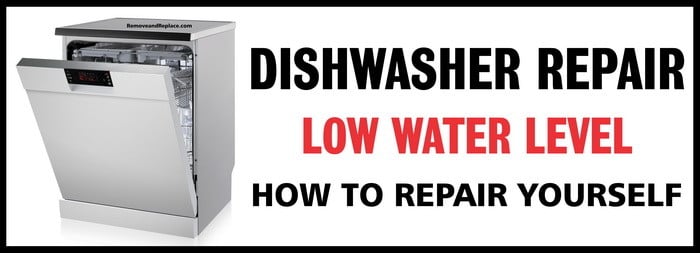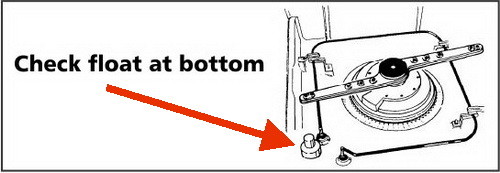Our new Whirlpool dishwasher is not getting enough water to clean the dishes properly. The water pressure is either too low or it is simply not getting enough water. The dishes on the top rack seem to not even have any water cleaning them as they are just as dirty as when they were put in. We just installed this dishwasher ourselves about a week ago. Could an improper installation have something to do with it? Could the water pressure be too low? What would cause this? Is it possible we installed the dishwasher incorrectly? Do you have any suggestions about what we should check?
If you have just recently installed your dishwasher, then we have a few reasons that may be the problem for low water pressure (or not enough water) in your dishwasher.
Possible (Low Water Level) Reason #1
When you installed your dishwasher you had to turn off the water shut off valve that is under your sink. It may be possible that you have forgotten to fully open the shut off valve. Check to be sure that the shut off valve is fully open. The shut off valve could also be clogged or not working properly. Check to be sure the valve is open and not clogged.
Dishwasher Not Filling With Water Properly
Possible (Low Water) Reason #2
The dishwasher drain hose may not have a loop in it. The fill water may be draining out of the dishwasher by going straight out the drain hose. Be sure that your drain hose is not simply laying straight. It must have a loop in it or be off the ground so the fill water (dishwasher cleaning water) is not gravity fed out via the drain hose.
Possible (Low Water) Reason #3
Empty the dishwasher, set it to run a wash cycle. Let it fill with water as normal. When the dishwasher begins the cycle, open the door and see where the water level is at. The water level SHOULD be just under the heating elements. If the water level is below the heating elements, fill a small bucket with water and manually fill up the dishwasher water level to just below the heating elements. Now shut the door and let it run. If the top rack is now getting water to it, then yes you are not getting enough water to your dishwasher. You should have a 3/8 water line going to your dishwasher. This line is what supplies water to your dishwasher. There may be a clog in your water fill line or water inlet fill valve. Remove the fill line where it attaches to the fill valve. Check to be sure there is nothing clogging the screen on the inlet fill valve. At this time also check the water fill line for blockage. During install something may have fallen down and is blocking the water from flowing properly.
Possible (Low Water) Reason #4
The dishwasher has a water level switch (aka overfill switch). This switch is usually on a simple float that sits at the very bottom of your dishwasher. Locate the float switch in your dishwasher and be sure nothing is preventing it from moving up and down freely. You can take the bottom service panel off and see the bottom portion of the plastic float. The bottom of the float pushes down on a small microswitch telling the dishwasher when to stop water flow. Be sure that the microswitch is not bent or out of place.
Possible (Low Water) Reason #5
The water inlet fill valve inside your dishwasher may not be working properly. You can test it using a multimeter. Even though the dishwasher is new, it is not out of the question that the inlet fill valve is defective.
Dishwasher Water Inlet Valve Testing
Possible (Low Water) Reason #6
Your home may normally have low water pressure. If this is the case, you may need to install a special low water pressure fill valve on your new dishwasher. You can test the water pressure in your home with a gauge. The average home has a water pressure from 20-120 PSIG.
Possible (Low Water) Reason #7
You may also want to check other components in your dishwasher to be sure there is nothing else that could be causing the low water issue. Also check under the sink for a possible kinked or restricted water line or hose.
The troubleshooting methods above will work on all types of dishwashers including Kitchenaid, Frigidaire, LG, GE, Whirlpool, Bosch, Amana, Kenmore, Samsung, and Maytag.
NOTE: Always think safety and disconnect power when working on appliances.
Do you know of another reason a dishwasher would have low water pressure? Please leave a comment below.





My water is cut off atm and I want to run the dishwasher. Can I manually add water before the wash and start the machine? Do I need to add more water during the cycle?
We had a similar low water issue with our old (last century) Whirlpool dishwasher. Note that this fix may also apply to newer and or other brands.
Problems were poor dish cleaning, little to no water at top rack and it didn’t sound right. When stopped and then restarted the water spray sound lasted only a few seconds, then quieted. Water level appeared low inside.
I hadn’t found this site yet, so I estimated that the water level should be less than the overfull shutoff float valve and a little above the heating elements. Note that the above article says just below the element. Several pans of water brought it to this level and it sounded and worked much better. Our washer has a timed fill rather than a level fill. So I checked and found that running it through the timed fill cycle 2 1/2 times brought it to the right level.
I figured a plugged screen, so pulled off the solenoid fill valve to clean it. There was some crud on the screen but not much. I took the valve completely apart for a more thorough cleaning. Drawing a diagram and marking parts here helps for easier and faster reassembly. The culprit was under the filter screen, a flow restrictor with only a 3/32 hole for water flow. Rather than just remove it I drilled it out to 2 1/2 times the area which was 5/32, hoping to match the above test results.
Success! It filled to the bottom of the element, very close to what was recommended above. It works good again cleans much better and sounds like it should too.
So, you don’t have to increase the fill time if you increase the flow rate by opening up the flow restrictor.
My whirlpool dishwasher has been making the “cavitating” sound for many years.
The only way I can get it to quieten down, is to add one quart of extra water during each cycle (there are 4 water inlet cycles, prewash, wash, pre rinse, and final rinse).
The cavitating sound got severe, so I removed the water inlet valve and found the strainer was clogged with a lot of copper-looking scale flakes.
After removing these flakes, the dishwasher is back to its original “cavitating” sound, which requires adding an additional quart of water during each cycle.
I have found no way to reprogram the water inlet timing software (I guess the number of seconds allowed for each water inlet time, is on a chip).
I also have a new whirlpool dishwasher acting similar. When it runs the motor makes funny noises. To me it sounds like it’s running dry at times due to not enough water. When I manually add water to the dishwasher say a couple-few large cups of water the noise goes away and dishes seem to come out cleaner. Water valve is open all the way and it’s a brand new water line 3/8. Tested water valve and it seems to work fine. Water level is below the element. It’s been doing this since the day it was installed. Anyone know if there is a way to increase the fill time?